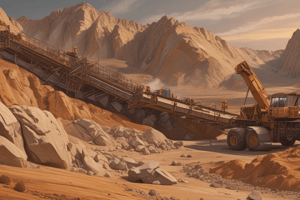Podcast
Questions and Answers
What is the primary purpose of pillars in room and pillar mining?
What is the primary purpose of pillars in room and pillar mining?
- To store mining equipment
- To facilitate transportation of ore
- To provide ventilation in the mine
- To support the roof and prevent collapse (correct)
What type of mining involves digging large holes into the ground to extract minerals?
What type of mining involves digging large holes into the ground to extract minerals?
- Shaft mining
- Slope mining
- Open-pit mining (correct)
- Drift mining
What is the main cause of rockfalls in mines?
What is the main cause of rockfalls in mines?
- Weak rock structures (correct)
- Gas explosions
- Human error
- Poor ventilation
Which type of mining is used to extract minerals from beneath the Earth's surface?
Which type of mining is used to extract minerals from beneath the Earth's surface?
What is the environmental impact of mining on nearby water sources?
What is the environmental impact of mining on nearby water sources?
What is the main health issue associated with mining?
What is the main health issue associated with mining?
Flashcards are hidden until you start studying
Study Notes
Types of Mines
- Surface Mines: Extract minerals or rocks from the Earth's surface
- Open-pit mines: Large holes dug into the ground to extract minerals
- Strip mines: Soil and rock removed to expose minerals
- Underground Mines: Extract minerals or rocks from beneath the Earth's surface
- Shaft mines: Vertical tunnels dug into the ground to access minerals
- Slope mines: Angled tunnels dug into the ground to access minerals
- Drift mines: Horizontal tunnels dug into the ground to access minerals
Mining Methods
- Room and Pillar Mining: Mining in a series of small rooms, leaving behind pillars for support
- Longwall Mining: Mining a long face of coal, using a machine that shears the coal from the face
- Sublevel Caving: Mining in a series of sublevels, allowing ore to collapse behind the mining face
- Block Caving: Mining in large blocks, allowing ore to collapse behind the mining face
Mining Hazards
- Rockfalls: Falling rocks or debris from the mine roof or walls
- Gas Explosions: Explosions caused by methane or other gases in the mine
- Dust Explosions: Explosions caused by coal or rock dust in the mine
- Respiratory Problems: Health issues caused by inhaling dust, gases, or other airborne contaminants
Environmental Impacts
- Land Degradation: Damage to the surrounding land and ecosystems
- Water Pollution: Contamination of nearby water sources
- Air Pollution: Release of pollutants into the air
- Waste Management: Disposal of hazardous waste generated by mining activities
Types of Mines
- Surface mines extract minerals or rocks from the Earth's surface
- Open-pit mines are large holes dug into the ground to extract minerals
- Strip mines involve removing soil and rock to expose minerals
- Underground mines extract minerals or rocks from beneath the Earth's surface
- Shaft mines are vertical tunnels dug into the ground to access minerals
- Slope mines are angled tunnels dug into the ground to access minerals
- Drift mines are horizontal tunnels dug into the ground to access minerals
Mining Methods
- Room and Pillar Mining involves mining in a series of small rooms, leaving behind pillars for support
- Longwall Mining involves mining a long face of coal, using a machine that shears the coal from the face
- Sublevel Caving involves mining in a series of sublevels, allowing ore to collapse behind the mining face
- Block Caving involves mining in large blocks, allowing ore to collapse behind the mining face
Mining Hazards
- Rockfalls occur when rocks or debris fall from the mine roof or walls
- Gas Explosions occur when methane or other gases in the mine ignite
- Dust Explosions occur when coal or rock dust in the mine ignite
- Respiratory Problems can occur due to inhaling dust, gases, or other airborne contaminants
Environmental Impacts
- Land Degradation refers to damage to the surrounding land and ecosystems
- Water Pollution occurs when nearby water sources are contaminated
- Air Pollution occurs when pollutants are released into the air
- Waste Management involves disposing of hazardous waste generated by mining activities
Studying That Suits You
Use AI to generate personalized quizzes and flashcards to suit your learning preferences.




